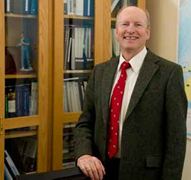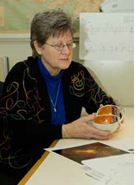Funding Stories
Read about research being undertaken in the Faculty of Medicine with the help of funding from the Medical Research Fund.
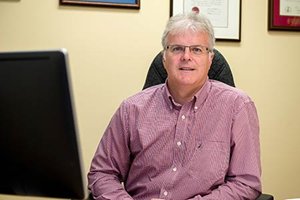
Dr. Vernon Curran, a medical education professor and 2014 recipient of a MUN Medical Research Endowment Fund (MRF) research development grant, is working towards expanding knowledge on the potential use of digital and social media technologies in supporting the self-directed learning activities of physicians.
Medical knowledge is constantly expanding. In order to ensure physicians are up-to-date on the latest advances in the treatment and management of their patients, medical licensing authorities mandate the completion of a number of required Continuing Medical Education (CME) credits on an annual basis. In most parts of Canada, these CME systems are overseen by the College of Family Physicians of Canada and the Royal College of Physicians and Surgeons.
Self-directed learning is one way in which physicians can undertake lifelong learning to stay up-to-date on the practice of medicine. Self-directed learning is a well-recognized type of adult learning in which physicians, with or without the help of others, plan and undertake formal or informal learning activities that address their own specific learning needs. In more recent years, as a result of technological advancements, digital and social media technologies have emerged that could offer opportunities for self-directed learning settings.
“We know that physicians are using the Internet, mobile technologies and social media to a much greater extent” said Dr. Curran, “but now with the growth of social media applications we wanted to learn more about how it may be being used for education.” Social media sites such as LinkedIn, Doximity and Twitter are ideal technological social realms for educational sharing, and in Dr. Curran’s case, they are ideal for research.
This field of study is extremely beneficial in a rural province like Newfoundland and Labrador. With a large number of physicians in the province practicing out of rural communities, self-directed learning and social media offer a potential efficient way to network, reduce professional isolation and support one’s professional development.
“This will actually provide the Faculty of Medicine with some guidance,” Dr. Curran explained. “Our Office of Professional Development has responsibility for planning and organizing continuing medical education. We also teach students and residents at the undergraduate and postgraduate levels. The study findings could help us in identifying better ways to prepare our learners and support physicians for their lifelong learning.”
Through conducting interviews and working with rural physicians around Newfoundland and Labrador Dr. Curran and his co-investigators – Lisa Fleet, Dr. Mo Ravalia and Dr. Pam Snow – will be exploring a phenomenological understanding of social media and its relation to medical education. By systematically conducting interviews and organizing the data collected, a deeper understanding of how medicine, social media, education and medical practitioners function together will be produced.
“What we find from the study might inform the type of training and education we provide to students on how to use social media effectively as part of their continuing education,” said Dr. Curran. “It’s a part of what we do to help students be confident self-directed learners.”
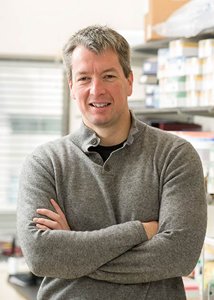
Dr. Michael Woods is hot on the trail of the genetic mutations associated with intracranial aneurysms.
There is currently only one option available for those who are potentially predisposed to intracranial aneurysms to screen and confirm their condition. Major medical equipment, such as, MRI and CAT scan tools can locate blood vessels within a patient’s brain that have pocketed and begun to pool blood. Doctors are then able to perform preventative surgery to prevent rupture of the vessel and its catastrophic consequences, such as a stroke. But what if there are no vessels pooling blood at the time of screening? Does an individual at risk of intracranial aneurysms need to undergo screening throughout their entire life? Genetic studies may be able to help in this regard.
Intracranial aneurysms are generally familial, which, put loosely, is when two or more family members have experienced an aneurysm, making it a matter of genetics. Dr. Woods is an Associate Professor of Genetics in the MUN Faculty of Medicine. With the support of a grant from the MUN Medical Research Endowment Fund (MRF), he is undertaking detailed investigations of the genetic mutations that are associated with intracranial aneurysms.
Dr. Woods’ research is based on the analysis of DNA samples obtained from intracranial patients and their families. “For what we do, it’s really valuable to study big families” Dr. Woods explained, “Newfoundland & Labrador has an advantage over many places for studying human genetic disease, because we do have very large families, and they stay in touch with one another.”
Dr. Woods and his team have been fortunate in working with two large Newfoundland families in their search for the genetic causes underlying aneurysms.
“It’s detective work in a lot of ways” Woods explained.
As each person, regardless if they have a genetic disease, has thousands of genetic mutations, it is very difficult sometimes to determine which one is related to intracranial aneurysms.
“It is similar to trying to find a specific needle in a stack of needles”, states Dr. Woods.
The money from the MRF has provided Dr. Woods with the necessities to begin conducting research in this field.
“Grants are very competitive in Canada, and this $20,000 will allow us to get the start-up research necessary to continue working towards identifying the genetic mutation.”
The funds provided by the MRF have allowed for the initial experiments on DNA samples collected here in Newfoundland to be performed at Genome Quebec and McGill University in Montreal, where a next generation sequencing machine generates the data necessary for the study. The data is then analyzed in Dr. Woods’ lab as are subsequent experiments.
Advances in this field of study could have direct impact on the health care system. By locating and then proving a genetic mutation to be related to intracranial aneurysms, family members of those who’ve previously suffered an intracranial aneurysm would be able to be screened in a much more cost effective and efficient fashion. Rather than costly MRI and CAT scan processes, which can require wait times, patients would be able to screen their genetic make-up by providing a simple DNA sample. While screening can indicate a genetic predisposition, Dr. Woods notes, in closing, that “individuals without this specific mutation are still at as high a risk as the general public, but at a much lower risk level than family members who carry the mutation”.
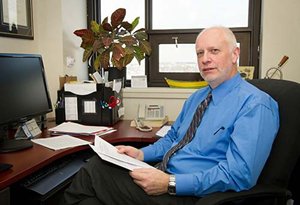
The proportion of seniors in the population of Newfoundland and Labrador is increasing. Provincial government population projections estimate that by 2025 close to one quarter of the province’s population will be aged 65 and over, with a growing number of individuals over 75.
Dr. Gary Tarrant, an associate professor of family medicine based at the Ross Family Medicine Centre, is concerned about the increasing need for long term care facilities for seniors. With the help of $20,000 funding from the Medical Research Endowment Foundation (MRF), he is heading up a study through the Primary Healthcare Research Unit (PHRU) to explore how health care services in personal care homes in Newfoundland and Labrador could be optimized by better co-ordination and integration of the key stakeholders.
“This is the first step of a research program aimed at understanding the current state of health care services in personal care homes and how health care services for this important sector can be improved,” said Dr. Tarrant.
In Newfoundland and Labrador, the Department of Health and Community Services determines overall funding for home care in the province and allocates resources among the various regions. The department is also responsible for establishing strategic directions and policies, and for monitoring programs. Day-to-day program management and responsibility for service delivery are delegated to the Regional Health Authorities.
“There’s very little research on personal care homes,” said Dr. Tarrant. “Personal care homes are not nursing homes and do not provide the same range of medical care as nursing homes – residents depend a lot more on their own family physicians for their ongoing health care needs.”
The Department of Health and Communities Services does assign to each personal care home social workers, community health nurses and other allied health professionals, who currently work with residents’ family physicians in an informal arrangement. Dr. Tarrant’s group will be investigating if there can be a more optimal co-ordination among the different stakeholders to improve health care delivery to the residents of personal care homes.
The data for this research study on personal care homes will be collected by interviews with key stakeholders, focus groups with physicians, and case studies. Interviews will be done with personal care home owners or managers in both urban and rural settings, clinical staff with Eastern Health assigned to the Personal Care Home Program, and officials within the Department of Health and Community Services responsible for overseeing residential care homes.
“The interviews will focus on issues such as the barriers or enablers, including policies or practice, that contribute to or inhibit the co-ordination of health care in personal care homes,” said Dr. Tarrant. “We want to find out how care providers or regulators provide input into policy decisions affecting personal care homes and how care providers, in particular family physicians, can improve linkages with social workers, community health nurses and other allied health professionals that provide health care services for the homes.”
The goal, said Dr. Tarrant, is to find how a co-ordinated service might improve the quality of health care for seniors living in personal care homes and reduce health care costs. “We also want to explore policy options for improving the co-ordination of health care in personal care homes.”
Dr. Tarrant has provided patient care in personal care homes for 27 years, and currently provides medical care for three personal care homes in the St. John’s area. As principal investigator of this project he will work with Dr. Marshall Godwin, director of the Primary Healthcare Research Unit, Dr. Victor Maddalena, assistant professor in health policy and health service delivery, Dr. Shabnam Asghari, an epidemiologist and assistant professor of family medicine, Janice Dalton, regional manager of the Personal Care Home Program for Eastern Health, and Andrea Pike, research manager for PHRU.
.jpg)
Although rare, juvenile-onset granulosa cell tumours can occur in the ovary of children and teens, posing a malignant health risk with associated loss of a reproductive organ in very young patients. Dr. Ann Dorward, Canada Research Chair in Molecular Signaling in Human Health and Disease, will use a $20,000 development grant from the Medical Research Endowment Fund to employ Next Generation Sequencing (NGS) technology to develop a comprehensive list of genetic variations unique to a particular mouse strain that develops spontaneous ovarian granulosa cell tumours, as a model for the human cases.
Dr. Dorward sees the value of mouse models to explore genetic determinants of cancer risk in people, particularly if the human cancer is rare in the population. The key to this current research project is the use of NGS technology applied to the mouse model, where the genetic determinants are already mapped to the mouse genome.
“Our genomic sequencing target represents a combined 3.7 million bases of DNA based on three distinct, mapped regions of interest – this represents only 0.1 per cent of 3.4 billion bases of mouse genomic DNA. Traditionally we mapped regions of DNA and examined small regions for candidate genes in a serial fashion, but now we capture and sequence the genetic information all at once with NGS technology. What took years can now take just a few weeks.”
To achieve the custom sequencing goals of this project, Dr. Dorward has enlisted the expertise of the scientific services and collaborators at The Jackson Laboratory in Bar Harbour, Maine, where she trained as a postdoctoral fellow.
“Our own genetics researchers at Memorial are moving towards this new technology, but right now I am happy to work with researchers at The Jackson Laboratory who have the NGS expertise, in order to familiarize myself with the capability and informatics challenges of this technology.”
The information obtained will help develop a comprehensive list of all the genetic variations present that contribute to early-onset granulosa cell tumour development in female mice. Dr. Dorward said that based on endocrinological, histological and malignant criteria, these mouse tumours have strong parallels with juvenile-onset granulosa cell tumours that appear in infants and young girls, supporting the translational potential of the genetic findings.
Dr. Dorward has established a collaborative agreement with Dr. David Huntsman of the BC Cancer Agency to expedite the translation of the findings from this project to human cases.
“The ultimate goal is prevention or early detection of these tumours to prolong life, preserve fertility and ensure the long term ovarian and endocrine health of young women.”
The research will also be of benefit to graduate research in Dr. Dorward’s lab. Fine mapping has already resolved the genetic regions of interest to a defined region of mouse chromosome 4 and two distinct regions on chromosome X. Acquisition of the full genomic sequence for the mapped regions will accelerate the PhD research for Kerri Smith and a master’s project for Zoha Rabie.
Dr. Dorward said she is very appreciative of the $20,000 MRF funding and is hoping to use the results of this project to define candidate tumour susceptibility genes for inclusion in a comprehensive Canadian Institutes of Health Research operating grant related to granulosa cell ovarian tumourigenesis.
By Sharon Gray.
An interdisciplinary group from biomedical sciences, chemistry and physics are pooling their expertise to engineer an artificial collagen scaffold that could be used for corneal reconstruction in the human eye.
“Our goal is to move into constructing a multi-layered artificial cornea that is compatible with corneal cells and remains clear,” explained Dr. Bob Gendron, professor of cancer/cardiovascular biology in the Faculty of Medicine. With his colleague Dr. Hélène Paradis, professor of vascular molecular biology/pediatric cancers, they are working with Dr. Kris Poduska, associate professor of experimental materials physics and chemistry, and Dr. Erika Merschrod, associate professor of chemistry, to develop an artificial cornea.
Their work recently received a $20,000 award from the Medical Research Endowment Fund (MRF) for the project titled A Novel Electrochemically Engineered Collagen Scaffold for Corneal Reconstruction.
“Kris and Erika are interested in materials and advanced engineering, particularly in analyzing collagen, which is one of the main components of connective tissue,” said Dr. Gendron. “They have figured out a way to marry concepts in physics and chemistry to quickly produce a collagen matrix which has all kinds of applications, especially in artificial tissues.”
This research was recently published in Macromolecular Bioscience in a paper titled Controlled Cell Proliferation on an Electrochemically Engineered Collagen Scaffold. The paper describes cell-culture studies showing that electrochemically prepared collagen matrices display high optical transparency, encourage cell attachment near the surface, and appear to stimulate normal signaling pathways in cornea specific cells.
“Overall, the evidence presented in this paper is an important step towards better engineering of artificial tissues,” said Dr. Gendron.
With the funding from the MRF, the group is working to construct a prototype multi-layered artificial cornea. Eventually they hope to move into a commercial application with the help of federal funding and industry partnerships.
Dr. Gendron noted that there is a critical shortage of corneas available for transplant. The corneas available come from people’s posthumous donation of their eye tissues. With an aging population more corneas are needed, while at the same time the increasing use of laser treatment on eyes means that fewer corneas are available.
“There is a real need to develop an artificial cornea, and the advantage is that an artificial cornea would not have immune issues and would not be prone to rejection,” said Dr. Gendron.
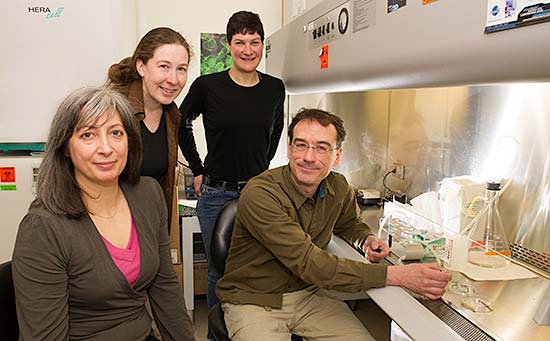
Researchers in biomedical sciences, physics and chemistry are working together to develop the basis for an artificial cornea. From left: Drs. Hélène Paradis, Erika Merschrod, Kris Poduska and Bob Gendron.
Photo by HSIMS
Dr. Andrew Smith, assistant professor of emergency medicine, has developed a multidisciplinary Point of Care Ultrasound Program (PoCUS) for residents attending Memorial. Now, with the help of a $20,000 development grant from the Medical Research Endowment Fund (MRF), he will undertake an evaluation of this training.
Dr. Smith said that ultrasound is a valuable tool being increasingly integrated into a multitude of different disciplines in clinical medicine. “As a safe and non-invasive imaging modality, ultrasound is quickly becoming the standard of care in a variety of procedures. For instance, there is clear evidence to suggest that the use of ultrasound decreases the number of attempts, increases success rates, and decreases complication rates when used to guide central line placement, thus playing a major role in improving patient safety.”
Other benefits of Point of Care ultrasound are that there is no radiation, the exam can be performed within minutes, and can easily be repeated. Given the tremendous benefits associated with the use of PoCUS, Dr. Smith said that the implementation of formal PoCUS training programs for residents would be an asset to residency education, benefiting both patients and the local health authority.
“Although formal PoCUS training programs for residents are well established within the Discipline of Emergency Medicine, very few formal training programs target multiple clinical disciplines and no programs are available which incorporate residents into teaching and administration,” he explained. “To address these gaps in PoCUS education, we have developed a multidisciplinary program which provides resident’s discipline-specific training in bedside ultrasound using the CanMEDS framework with the goal of improving patient safety and decreasing health care costs.”
The implementation of the ultrasound-guided central lines component of the PoCUS program consists of online learning, practical training, development of competence, and subsequent knowledge transfer via teaching. To be granted certification in ultrasound guided central line placement, residents must place a total of 10 ultrasound guided lines and the quality of their line insertions must be documented by their supervisor using the PoCUS Program Vascular Access Log. “After successfully completion, residents are strongly encouraged to become teachers and mentors for other residents within the program,” said Dr. Smith.
The MRF-funded evaluation project will involve residents completing a pre- and post-survey which will assess residents’ knowledge and comfort in placing lines before the beginning of the online learning component and six months after completing the practical training session. Knowledge and skill gains will be assessed by examining the difference in scores from the pre- and post-survey of the resident’s self-assessed competence regarding central line placement, which will be compared to objective evaluations of performance.
The post survey will also ask residents to rate the effectiveness of the program in developing CanMEDS roles as well as rate their experience and confidence in teaching other residents how to place ultrasound guided central lines. “Trends in competency development and mechanical complication rates as the program transitions from being taught primarily by faculty members to residents will be assessed using data from the PoCUS Vascular Access Log,” said Dr. Smith. “Trends in the rate of catheter- related bloodstream infections over time, using standardized hospital data, will also be monitored as part of this project.”
Dr. Smith said the MRF grant will foster research in both medical education and clinical applications pertaining to Point of Care Ultrasound at Memorial. “This funding will improve our success in obtaining further grants from both local and national agencies. An unforeseen benefit of this particular MRF grant is the increased multidisciplinary collaboration in education, research, and clinical care as we strive to provide the best educational experience for residents while improving patient safety at the same time.”
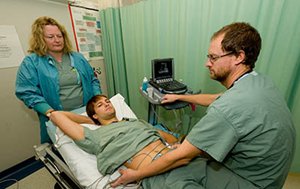
Drs. Tia Renouf and Andrew Smith demonstrate an ultrasound machine on Dr. Andrew Dyck.
It will be a banner year for grants from the Medical Research Fund (MRF), thanks to top-up funding from the Faculty of Medicine.
Normally three development grants in the amount of $10,000 each are distributed annually. This year Dean James Rourke has agreed that the Faculty of Medicine will allocate money to the MRF in order to increase this to five $20,000 research awards in 2012.
“The need for pilot project research grants was identified as one of the keys in increasing research success during our Strategic Planning Retreat,” said Dr. Rourke. “From this the Faculty of Medicine will be working on an action plan to enable research success including increased funding for pilot project research grants.”
Following the Strategic Planning Retreat, held Nov. 29-30, Dr. Rourke met with the chair of the MRF board, Dr. Bruce Van Vliet, and they discussed ways to make an immediate impact on research funding.
Dr. Van Vliet noted that the usual awards of $10,000 each do not go far towards the costs of developing contemporary research programs. “It is also a modest sum relative to tremendous resources that our faculty puts into the process – in the past year applications were assembled by 13 teams and were subjected to detailed review by a committee of five faculty members.”
The formal announcement of the 2012 competition for the development grants will be made in mid-January, with the deadline for applications in mid-March.
The Medical Research Fund (MRF) is a research endowment fund established by Memorial University of Newfoundland to assist the Faculty of Medicine in its objectives of developing and maintaining research excellence to meet the needs of the province and its people. The MRF holds two research grants competitions each year and is dedicated to making quality research and health initiatives a reality for our community.
Since 1992, the MRF has supported more than 50 research projects through Research Development Awards and the Cox Award. More than one million dollars in research funding has been disbursed. MRF awards provide critical support for the development of health science research projects, often enabling new ideas and collaborations to be developed to a point that they may attract major funding from external granting agencies such as the Canadian Institutes of Health Research.
For further information on MRF awards, or tax-free donations to the endowment, please visit here.
For the past two decades, the Medical Research Fund (MRF) has supported researchers in the Faculty of Medicine with operating grants and awards. Although the amounts are not large – generally from $10,000 to $30,000 – these awards can lead to important results and success in obtaining federal funds for further research.
Dr. Jane Green received a $25,000 Dr. A.R. Cox Award in 2006 for a study on inherited juvenile macular degeneration in Newfoundland and Labrador. "This funding was used to identify mutations (gene changes) in Newfoundland families with Stargardt Disease, a severe early-onset hereditary eye disorder, and to interview family members about the impact of this disease on their education, employment, and family life."
The MRF funding enabled Dr. Green and her research team to partner with Genome Canada funding, which substantially increased the research that could be done. The results were significant. "We identified mutations in members of 20 families in the province, who may now be able to participate in up-coming trails for gene therapy to improve their vision," said Dr. Green.
Many other researchers in the Faculty of Medicine credit the MRF funds with providing invaluable help just when it was needed. Dr. Bruce Van Vliet, who has received several MRF grants for his research, said the money has provided critical support at many points. "The funding allowed us to do important work at the time and also helped us build our experience and expertise to a point where we can now make our most exciting research findings."
Dr. Guang Sun is enthusiastic about the benefit of the Medical Research Fund. "I received MRF funding for my lab in 2002, the second year of my faculty position. I desperately needed seed funding to obtain preliminary data. The MRF helped me in part to succeed in the success of my first CIHR operating grant application in 2003. The CIHR funding directly led to the discovery of 45 obesity related genes which has been highly valued by national and international researchers in the field of obesity study."
For Dr. Ken Kao, funding from the MRF in 1998 led to publication an important paper that was critical for renewal of a Canadian Institutes of Health Research operating grant.
Other researchers have found MRF funding essential early in their career. "The MRF funding helped to develop my research in a new area and I was subsequently able to get another $500,000 in CIHR funding," said Dr. Sudesh Vasdev. "The kind of bridge funding provided by the MRF is always needed."
Dr. John Mclean knows from experience the value of MRF funding. "In 1996 I received an operating grant of $25,000, which provided me with bridge funding and enabled me to keep my research going so I could obtain preliminary data for my next external grant proposal."
Dr. Christopher Kovacs also appreciates the value of his MRF grant in 1998 in developing his career. "The MRF award is not an amount that you could operate a lab on but it is enough to get a smaller project done in a year, or to get pilot data in order to justify a larger project and grant application. Certainly data generated with the MRF was used as preliminary data in my first – and successful – MRC (now CIHR) grant application. And I've been continuously funded by MRC/CIHR since then so the MRF definitely helped to jump-start my independent work at a key time in my early career. Without it, I could have been stuck not getting my first MRC grant for lack of data, and running out of start-up funds with little hope of getting additional data for a resubmission. I wish there were more funding awards available like MRF to enable pilot studies to be done, or to use as bridge funding when an investigator's grant doesn't get renewed but there's a likelihood of renewal if a year or so can be spent getting additional data."
The Medical Research Fund (MRF) is an endowment fund established by Memorial University of Newfoundland to assist the Faculty of Medicine in its objectives of developing and maintaining research excellence to meet the needs of the province and its people. Dr. Van Vliet, chair of the board of the MRF, said the awards from the MRF are providing payoffs in the development of the Faculty of Medicine’s research programs. "These awards increase our ability to develop our programs and bring large grants into the institution and province. The important results produced by these research programs benefit us all."
For further information on MRF awards, or tax-free donations to the endowment, please visit here.
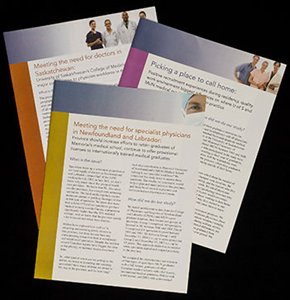
Building on the work she has done on physician workforce issues in Newfoundland and Labrador, Dr. Maria Mathews is undertaking a new project to study the stability of this workforce. This project is supported by a $20,000 development grant from the Medical Research Endowment Fund (MRF).
Dr. Mathews, professor of health policy/health care delivery in the Division of Community Health and Humanities, explained that the measurement of physician to population ratio is often used to compare the supply of physicians in different provinces and countries.
“Although it is easy to calculate, this measurement provides little information about the actual workforce that serves a population,” she said, noting that some of the questions not covered by the physician to population ratio include turnover, the number of unfilled positions, and the needed number of different types of physicians.
To find answers to these questions, Dr. Mathews will develop new measures such as stickiness, inflow and outflow, in order to consider and compare the stability of the physician workforce and the characteristics of the physicians who enter, stay or leave the workforce in a given time period. “We will look at communities that are ‘sticky’ or retain their physicians, versus communities with high turnover, and examine how physician turnover affects health and wellbeing.”
Dr. Mathews said the measurements will be calculated for geographic regions and for physician specialties. “To validate these measures, we will compare the stickiness measures in each local area to physician availability data collected in previous surveys such as the Canadian Community Health Survey. Our study will provide a valuable tool that will help manage physicians supply in different regions in Canada.”
With the help of additional funding from the dean of medicine, Dr. James Rourke, the 2012 MRF Research Development Grants have been increased to $20,000. Dr. Mathews said this funding will allow her to do initial work on measuring physician workforce, which can lead to getting larger national grants for further research in this area.
Dr. Guangju Zhai, Discipline of Genetics, has received the 2011 Cox Award of $30,000 for a preliminary study of epigenetic influence on osteoarthritis (OA).The Cox Award is given out annually through the Medical Research Fund (MRF).
“Osteoarthritis is the most common form of arthritis and has a huge clinical and economic impact,” explained Dr. Zhai. “There are about three million adults (one in 10) affected by OA in Canada, including roughly 85 per cent of the population over 75 years, with approximately twice as many females as males. It is predicted that, by the year 2031, the number of people with arthritis in Canada will more than double. The economic burden of arthritis in Canada was estimated to be $6.4 billion in 2000, most of which was due to OA.”
Dr. Zhai said OA is a complex disease that is not completely understood. ““While several environmental factors such as age and obesity have been clearly associated with OA, approximately half of the risk of OA is due to genetic factors. We have recently identified several genetic changes that predispose to OA. These discoveries have improved our understanding of the causes of OA. However, the risk for any of these genetic changes is quite low, and a substantial proportion of the causality for OA still remains unexplained. DNA methylation is the process in which a methyl group is added to the cytosine pyrimidine ring. Its role is to turn genes ‘on’ or ‘off’. Emerging evidence suggests that DNA methylation plays a significant role in the development of OA and could account for the largely unexplained causality of OA.”
The aim of the study is to examine whole-genome DNA methylation pattern in the articular cartilage tissue obtained from 10 patients who undergo total hip joint replacement due to primary OA, and 10 control patients who undergo total hip joint replacement due to hip fracture who are otherwise healthy, to identify differentially methylated DNA regions that confer a larger risk of OA.
Dr. Zhai said the study results will support an operating grant application to the Canadian Institutes of Health Research. “The field of epigenomics is in its infancy and any success in this field in linking changes to common human diseases such as OA will have a major impact on the field.” He noted that epigenetic changes, although heritable at the cellular level, are potentially reversible, and could be a new molecular target for therapeutic intervention, especially early in the disease.
This project is in collaboration with Drs. Andrew Furey and Glynn Martin, Orthopedics, who are responsible for identifying study participants and collecting cartilage samples from joint replacement patients; Dr. Guan Sun, Genetics, who advises on DNA and RNA extraction from cartilage tissue as well as novel gene expression and methylation methods; and Dr. Roger Green, Genetics, who co-supervises two master’s students, Zoha Rabie and Erfan Aref Ashghi, who are working on the project. Michelle Simms, a lab technician, and Yuhua Zhang, a statistician, are also involved in the project.
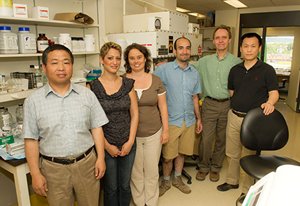
From left: Yuhua Zhang, Zoha Rabie, Michelle Simms, and Erfan Aref, Ashghi, Dr. Roger Green and Dr. Guangju Zhai.
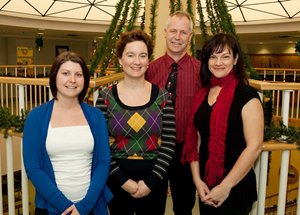
Diabetes research in the Faculty of Medicine is advancing thanks to a $30,000 Cox Award in 2009 from the Faculty of Medicine’s Medical Research Fund. Dr. Leigh Anne Newhook, Pediatrics, has teamed up with co-investigators Dr. Don MacDonald and Kayla Collins from the Newfoundland and Labrador Centre for Health Information (NLCHI) to conduct a unique study using clinical and administrative data on childhood diabetes.
“The findings from this study could have a direct impact on understanding the environmental risk factors of childhood diabetes, health practice, health care planning and future research initiatives,”said Dr. Newhook.
The study is looking at maternal and neonatal risk factors for type 1 diabetes mellitus among children aged 0 to 15 years in Newfoundland and Labrador. “This is a case-control retrospective study,” explained Dr. MacDonald. “We will study and compare potential risk factors in children who have diabetes compared to children of the same age and sex who do not have diabetes.”
Rates of childhood type 1 insulin-dependent diabetes are steadily increasing in many parts of the world. Newfoundland and Labrador has the highest incidence of childhood diabetes in North America and the third highest in the world. Children with insulin dependent diabetes must take several needles every day or use an insulin pump to survive. There are many complications of this disease including seizures from low blood sugar, acidosis from high blood sugars, and long-term damage to the eyes, blood vessels, and kidneys which can lead to blindness, kidney failure, nerve damage and heart disease.
Although certain genes are necessary for a child to develop diabetes, the cause of this disease is unknown. “Evidence derived from research in this area points toward an increased effect of unknown environmental factors which may be triggering the onset of the disease, “said Dr. Newhook.
“We will look at risk factors including the mother’s age, method of the baby’s delivery, pregnancy-related diabetes and other complications of pregnancy as well as marital status and education. Infant risk factors of interest include birth order, prematurity or full-term birth, complications at birth and birth weight.”
Cases of diabetes will be identified using the Newfoundland and Labrador Diabetes Database (NLDD) for childhood diabetes, maintained by the Janeway Pediatric Diabetes Research Team. This database contains data on all cases of type 1 insulin dependent diabetes in children diagnosed from 1987 to present.
The Live Birth System, an administrative database maintained by NLCHI and containing data on all live births in Newfoundland and Labrador from 1992 to present, will be used to obtain demographic data and clinical factors related to the risk factors of interest related to the pregnancy and birth. Ethics approval for this study has been obtained and the team hopes to have the study completed in about a year. Dr. MacDonald said the Cox Award was an important catalyst in moving this research forward.
Dr. Newhook said the study will help identify environmental risk factors associated with the onset of type 1 diabetes. “This is a critical first step toward addressing the high incidence of type 1 diabetes in Newfoundland and Labrador and protecting the health of our population.”
Members of the Janeway Pediatric Diabetes Research Team have been studying the incidence and prevalence of type 1 diabetes in children in the province over the past two decades. This is the second time that the Janeway Pediatric Diabetes Team has collaborated with NLCHI for the purposes of studying type one diabetes in Newfoundland and Labrador. For the purposes of this current study NLCHI will provide the data and office space necessary and will provide training and ongoing database and software support to the research assistant hired through this grant.
Other members of the research team include Dr. Reza Alaghehbandan, Nicole Edwards, Kerry LeFresne and Jennifer Philips from NLCHI; and Jackie Fiander and Sharon Penney from the Janeway Diabetes Research team.
In the photo:
From left: Kayla Collins, Dr. Don MacDonald, Dr. Leigh Anne Newhook and Jackie Fiander.
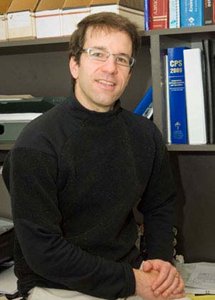
With the help of a $30,000 Cox Award (2008), Dr. Kris Aubrey-Bassler is undertaking a study that will shed light on obstetrical services for women in rural areas of the country.
As a member of the Primary Healthcare Research Group (PHRU), Dr. Aubrey-Bassler’s research is looking for results that have clinical relevance.
“The information collected from this study will allow women, particularly from rural areas, to be better informed when choosing the delivery location most suited to their needs. For example, we will provide information on the level of risk (if any) to a woman that chooses the convenience of delivering at a local hospital with a lower level of services rather than travel to a more highly specialized hospital. This information will also help policy makers to determine the most appropriate level of care to offer at rural hospitals.”
Dr. Aubrey-Bassler explained that women from rural areas where obstetrical deliveries are not performed often face long travel times to reach a hospital that does offer these services. “Where obstetrical programs do exist in rural areas, local volumes usually don’t allow a full range of services such as those that are offered in large urban centres. “
The researcher said that previous research suggests that neonatal mortality, hospital charges, and the risk of an abnormal neonate are all greater for women with poor access to care at their home hospital, even though those women are usually travelling to deliver at high volume, specialized centres.
“In determining the obstetrical outcomes for rural women, it appears as though proximity to care is more important than the level of service offered. Despite this, obstetrical programs in small rural hospitals are closing –we estimate that 25,000 Canadian women per year must travel away from their home communities to deliver their babies, often at great inconvenience and expense.”
The study will look at the outcomes for women and their babies from all regions of the country, ranging from those with no services to the most highly specialized centres. “We are primarily interested in comparing the outcomes for women from areas with no services to those from similar areas with higher levels of service,” said Dr. Aubrey-Bassler. “From this information, we hope to help clarify the optimal level of services required at rural hospitals.”
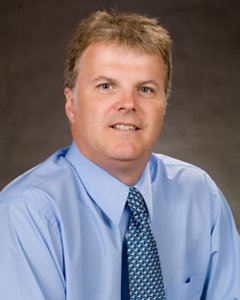
Dr. Vernon Curran, professor of medical education and director of academic research and development, has received a 2010 Research Development Award from the Medical Research Fund (MRF) for a survey study of resuscitation skills retention amongst health providers in Newfoundland and Labrador.
“In terms of the level and extent of staff training and development that occurs within hospitals and across the health system, continuing education for health providers in the area of resuscitation and life support skills is significant,” said Dr. Curran. “Across the four Regional Health Authorities in the province, it’s estimated that more than 10,000 health providers across a variety of professions are trained or certified in a variety of resuscitation and life support skill areas.”
Although most of these health providers can successfully learn to perform resuscitation and life support, research on the retention of resuscitation skills has shown that deterioration in skill level occurs across professions and across a number of resuscitation skill areas. “Studies have reported skills deterioration within a minimum of two weeks of initial training with progressive deterioration until participants reach pre-training levels at one and two years after initial training,” said Dr. Curran.
Research findings definitively support more frequent review than annual recertification. “Regular practice and training has been identified as one effective strategy to reduce anxiety and increase comfort levels when performing resuscitation and life support,” said Dr. Curran. “Techniques which provide for even minimal practice have resulted in significantly improved resuscitation skills retention. However, the optimal interval to facilitate ‘boosters’ and the effectiveness of different tele-education –for example distance learning – modalities for facilitating boosters has not been determined nor examined in a systematic and comparative manner.”
Dr. Curran’s study will examine the perceptions and attitudes of certified resuscitation providers towards the retention of resuscitation skills and regular skills updating, examine resuscitation providers’ self-efficacy beliefs towards resuscitation skills, and explore resuscitation provider’s perceptions of methods and modalities for enhancing resuscitation skills retention.
The study will be guided by an interprofessional advisory group reflecting health managers and health providers from across the four Regional Health Authorities. It will involve include a literature review, focus groups and a survey questionnaire.
“The findings of the research will have direct implications for resuscitation skills training policy and programming,” said Dr. Curran. “The findings of the study would be used to inform future research projects in the fields of resuscitation skills retention and deterioration, utility of booster training in skills retention, and the use of low and high-fidelity simulation, tele-education and other teaching and learning modalities in the assessment and training of resuscitation skills in rural and remote areas."
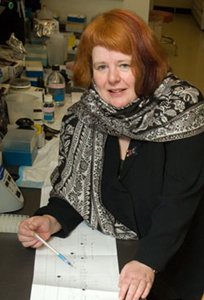
Further research on sudden cardiac death in young men is being supported by a 2010 Research Development Award from the Medical Research Fund (MRF).
The team of Drs. Kathy Hodgkinson, Sean Connors, Terry Young and Fiona Curtis are only too familiar with the gene mutation that causes arrhythmogenic right ventricular cardiomyopathy (ARVC) type 5 (ARVD5).
“In many cases sudden cardiac death is because of one gene mutation in the gene known as TMEM43 that has been passed through the generations, which causes the electrical system of the heart to malfunction,” explained Dr. Hodgkinson. “This mutation has caused the deaths of many Newfoundlanders, some named and remembered, some forgotten, the resting places of whom can be found in the graveyards of isolated communities across the province. This is the genetic burden that has been faced by many Newfoundland families.“
These families provided the samples that allowed the gene mutation causing this disease in TMEM43 to be found in Dr. Young’s laboratory. “This made it possible to determine the way the mutation affects individuals across a lifespan and which diagnostic tests are most effective,” said Dr. Hodgkinson. “From this research we know that the Holter Monitor – a 24 hour assessment of each heart beat – can detect early signs of this disease. We have also been able to show that treatment with a cardioverter defibrillator, implanted by Dr. Sean Connors, the elecrophysiologist responsible for the cardiac clinical care of these patients, shocks the heart back to a normal rhythm and leads to fewer deaths.”
The MRF funding will be used to answer one of the several remaining questions. “So far, all the ARVC families have had a family history of sudden cardiac death. This means that we already 'suspect' the presence of the gene, and can test family members. However, if families are small, or if individuals do not know their ancestry, then they may be at-risk for having this gene but remain unaware. We want to find out if this specific TMEM43 mutation is the cause of abnormal heart beats in young people without a family history of SCD. This will enable us to provide appropriate treatment, in addition to providing information about how common this gene may be in Newfoundland.”
The researchers will look at people who have abnormal heart beats but have not had a heart attack. “With the help of our cardiology colleagues we will ask people between the ages of 18 and 40 who display abnormal heart beats on a Holter Monitor whether they will speak with a genetic counselor about this study,” said Dr. Hodgkinson. “We will explain that we need a blood sample to see if they have the TMEM43 mutation, and what we know about the way this gene mutation works. If we find the TMEM43 mutation, they will be offered counseling and treatment. Their family will be offered genetic counseling to discuss genetic testing. As with all genetic diseases there are many factors to be discussed when deciding whether to have a gene test or not. These will be explained in detail. At any time before the blood sample, the person can decline to take part.”
Dr. Hodgkinson said the aim of this type of health research is to effect change in the lives of the people affected with this mutation. “This research may have a direct impact on those taking part. However, all the results – both positive and negative – will help us to have a much better idea of how common this mutation is, and thus the impact it may have on our health care delivery system.”
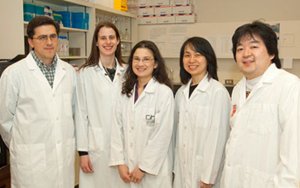
The 2009 Cox Award, valued at $30,000 went to Drs. Kensuke and Michiru Hirasawa for their joint application “Analysis of Brain Gene Expression in Juvenile Obesity Model.”
This application from two established investigators within the BioMedical Sciences Division concerns the hypothalamic regulation of appetite, including the transmitter systems responsible for laying down memories associated with dietary fat intake. The project makes use of a gene expression array approach, which was recognized for its great potential to lead to novel and potentially significant breakthroughs concerning the underlying hypothalamic mechanisms.
In the photo: From left: Christian Alberto, research assistant; Katrin Zipplerlen, research assistant, Dr. Sherri Christian, post-doctoral fellow, Dr. Michiru Hirasawa and Dr. Kensuke Hirasawa.
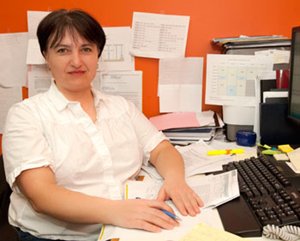
Dr. Sevtap Savas is researching the genetic factors affecting survival in colorectal cancer patients. Her work has earned the support of the 2010 Albert R. Cox Research Grant Award from the Medical Research Fund (MRF), valued at $30,000.
